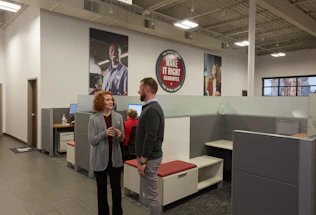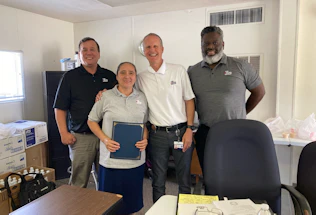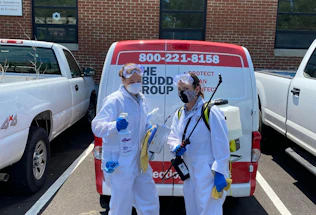If you are using a chemical for office cleaning, chemical safety is very important. Proper use of a chemical bottle and ensuring the use of PPE boost cleaning safety when handling chemicals.
Video Transcript:
Speaker 1: All right, Budd Group Team, we are here in this J closet to talk about something that our folks have to do every day and that’s mixing chemicals. We’re here with our account supervisor, Cassandra, to talk about how we can do this safely. Make sure that when we mix the chemicals we are doing it efficiently, effectively and safely so that when we do take that chemical out, we can get the job done the way that we need to. What are the first things we need to know before we get mixing any chemicals?
Cassandra: Have your PPE on. Your protective equipment. Your goggles, your gloves so no spillage on your hands or in your eyes.
Speaker 1: That’s right. Definitely want to keep it out of our eyes. That’s super, super important, I’m glad you mentioned that and you just never know. Sometimes it can splash back up or we may spill it. So that’s very good. Okay, so I noticed this bottle has a label on it. What do we need to know about bottles and labels?
Cassandra: We need to always make sure that your labels match the chemicals that you’re putting into your bottles.
Speaker 1: Very good. Okay. Anytime we’re pouring a chemical out of something and into something else, we want to make sure that the bottle that we’re pouring out of it has a label and that that label matches the bottle that we’re pouring it into.
Cassandra: Yes.
Speaker 1: Okay. This method that we have here is what we have at some of our accounts and it is called the RTD method or Ready To Dispense. And if you’ll notice, this is actually a different type of label than is on this bottle because this is not what Cassandra typically uses at [inaudible 00:01:34] just for demonstration purposes. She’s just going to walk us through how you would do this without actually dispensing the chemical.
Cassandra: Okay. So you would always make sure that your water was turned on.
Speaker 1: Okay.
Cassandra: And open up your bottle, away from your face. Always thinking about the safety. Place it in and then you would just dispense.
Speaker 1: Just like that. Very good. As simple as that. And then once you dispensed it, what do we need to do?
Cassandra: Okay, once you turn your water off to make sure that you disconnecting it.
Speaker 1: Just like that.
Cassandra: Yes.
Speaker 1: Very good.
Speaker 1: So this is really important, Budd Group Team. If we leave that water on, it’s going to allow that water to build up right here at the bottle could cause a gasket or something to break. And the next thing you know we’d have water all over this. So super important to turn the water off and disconnect that RTB dispenser. Okay, very good. At this account we actually use the J Fill. Cassandra, how would you use this chemical mixing method?
Cassandra: I would turn it on first and make sure everything’s on. Take the top off the bottle. Make sure that I select the proper selection, which is crew for the chemical that we’re about to dispense. Clear the line. Once it’s clear, place the bottle under the nozzle, push and fill.
Speaker 1: Very good. What a cool piece of equipment.
Cassandra: Yes.
Speaker 1: It sure does make it easy. And then I always recommend go ahead and clear the line when you’re done as well, just in case somebody gets in here and forgets to clear it before they use it. All you’re doing when you’re clearing it out is making sure that if you’re swapping from one chemical to another that you’re not mixing them in the container that you’re using.
Cassandra: Yes.
Speaker 1: Very good. And then we just turn the water off.
Cassandra: Always turn the water off.
Speaker 1: That’s right. The last method, which we use a lot when we’re working with floor and floor care is having to just mix the chemicals by hand. If we mixing the chemicals by hand, say in a mop bucket, what were some of the things we need to know about that?
Speaker 1: Always put the water in first and make sure that you have the proper ratio for the water to the chemical.
Speaker 1: Okay, very good. Always important to get that water in there first. That’s going to keep the chemical from hitting that hard plastic and splashing back up into our eyes. Again, very important to make sure we have the right PPE on. And like as Cassandra said, we want to make sure that we know the ratio before we start pouring that in there to make sure we’re mixing and diluting that chemical at the right rate. Very good. These are all great things to know. And the last thing I would say is anytime we’re mixing chemicals, we need to be sure that we know where our SDS or our safety data sheets are located for the account. And the reason this is important is sometimes accidents happen and if you were to get a chemical in your eye or somewhere where where it’ll start to cause irritation, we’d want to make sure that we can go to that SDS sheet and see all the chemical propers that we needed and go ahead and report that in the proper ways. Thanks for having me and I look forward to seeing you soon.
Cassandra: And thank you.
Speaker 1: Absolutely.
Speaker 3: Safety tips for mixing chemicals. First, always wear the appropriate PPE, including gloves and safety goggles. Before you fill up an empty chemical bottle read the label. The dispensing container should have the matching label of the bottle. If you’re using an RTD or ready to dispense first, connect the tubing and then turn on the water. Fill the bottle as needed, and then turn the water off and disconnect the RTD. If you’re using a J Fill first, select your chemical and then clear the line before and after you fill the bottle. If you’re filling by hand first, put your water in for our proper ratio of chemical to water. Refer to the SDS if you have any questions or spills or accidents.
The Budd Group strives to be a God-honoring company of excellence safely delivering services in janitorial, maintenance, and landscaping; offering development opportunities for their employees; and contributing to their community.
Interested in working for The Budd Group? We are hiring and offer benefits!
Find a Job
We have locations in Florida, Georgia, Kentucky, Mississippi, North Carolina, South Carolina, Tennessee, Virginia, and West Virginia.
Please use the links above for applying to The Budd Group for any position throughout our company. However, if you need to contact someone regarding a specific question, please use the phone number or email for the office nearest you from the list below.








